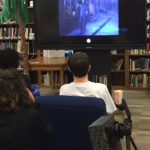6 years after creating our first makerspace, it only makes sense to publish a post that focuses on 6 steps for creating a makerspace.
Step 1: Create a personal philosophy for what making means.
6 years later, I have learned that what makerspaces are should be deeply personal to those who create them. With many still too hung up on what to buy for their spaces, even more paramount to that is taking the time to uncover exactly what making means to you is a key first step in creating a makerspace. Doing so, will help guide all of your makerspace decisions, including what to buy if anything at all.
Step 2: Plan and create a library makerspace that is grounded in research and evidence-based practices.
Something I am most proud of, is that my first book, Worlds of Making, is focused solely on the research and best-practices for planning and creating makerspaces. This does not discount the expertise of individual educators, but rather means integrating individual expertise with the best available evidence from systematic research. The conscientious use of evidence in making decisions about the learning environments we are trying to create a key to creating spaces that will have the greatest impact on our students, not only for now, but also into the future. The evidence and research by themselves, do not make all of our makerspace decisions, but they help lay a strong foundation and support us through the process of planning and creating a makerspace.
Step 3: Design a library makerspace (both physical and digital) that supports making principles and engenders constructivist learning theories.
My second book, The Kickstart Guide to Making GREAT Makerspaces, identifies key making principles, including the 7 attributes of a ‘GREAT’ makerspace. As anyone who has read my books knows, I define a makerspace as a unique learning environment that encourages tinkering, play, andopen-ended exploration for all. With this in mind, it is important to remember that what we are really trying to create is a unique learning environment. Unique learning environments require unique pedagogical approaches, and in the case of makerspaces, they engender constructivist learning theories, as outlined in my first book. It is critical to identify ways a makerspace can support constructivist learning theories and how constructivist learning theories can drive our makerspace designs.
Step 4: Propose a range of strategies for assessment of skills in a makerspace, including digital badging.
Makerspaces, as unique learning environments, afford us to the opportunity to seek out unique assessment methods. In a maker environment, it is important to find ways to acknowledge the granular skills students gain as well as ‘soft skills’- things such as teamwork and communication skills. We have an opportunity to not only assess in the traditional sense, but to give students credit for skills they gain, allowing them to stack skills and grow and refine them over time.
Step 5: Propose ways to unleash student creativity with innovative tools and maker project ideas.
I firmly believe that one of the most significant roles we have as maker educators is to provide the conditions to inspire our students to want to make and create, as opposed to always forcing them to make. I always say that I feel like the wizard behind the curtain in the Wizard of Oz, working hard to unleash creativity and to keep our space fresh, meaningful, relevant and inspiring to our school community.
Step 6: Evaluate various models for making and creating, including the design thinking process.
Providing models to guide our students through the process of making and creating has distinct benefits, and there certainly are many of them out there, including the design thinking process. Some students may identify with one over the other. Our ultimate goal should be to support our students to ultimately take ownership of their making and uncover their own process for making and creating.
With these 6 steps in mind, I am happy to announce a new course that I have created for Advancement Courses, called “Makerspaces in the School Library. ” This course takes a deeper dive into these 6 steps and more!
In this course, you will learn how to plan, create, manage, and facilitate your own unique, meaningful, and relevant makerspace. You’ll develop strategies to design both physical and digital tools for your makerspace; incorporate assessment and digital badging, and choose effective budget-friendly makerspace products. Through a survey of academic literature and real-life examples, you will examine best practices for establishing makerspaces and gather several ideas for makerspace challenges and prompts to inspire students to create. Using the resources and techniques from this course, you’ll be able to nurture your students’ creativity and foster a culture of making and creating in your library.
Something we are super proud of is that this course features a digital badge that you can earn, for the skills and knowledge that you gain from your learnings. The badge is earned through exemplary work in the course and on its final project—a project that you can put to work in your classroom right away to begin changing the learning experience for all your students! Your badge also represents the hard work you’ve put into your personal and professional growth as an educator, and you should share this achievement with your peers! The personalized artifact that you create in the course will be the greatest example of your expertise and skills, so make sure to save it so you can share it with others when discussing your badge.






